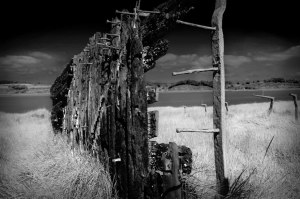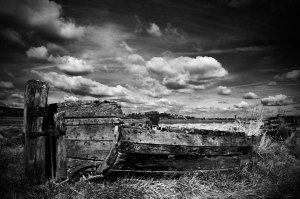A place changes through the placement of objects within the landscape, and as the objects placed within the landscape undergo entropy, the value of the place and its object contained therein change, giving to us a direction of time. The change is accelerated as the stories, histories, images and names that record the layers in the landscape grow and evolve.
The village of Purton is at first glance very much like many of the hundreds of small villages in England, with its farms, a pub, a church and a dozen cottages. The views around the village are rather nice, especially towards the Cotswold escarpment, along the Gloucester and Sharpness canal and across the wide expanse of the River Severn. It is along the river and canal that we must look to find the reason why Purton is different.
The Gloucester & Sharpness canal was designed to carry vessels of 600 tons and more, and in 1905 over 1 million tons of cargo were transported between Gloucester and Sharpness. The River Severn is at its widest point here, before it becomes the Bristol Channel.
In 1909, the course of the river at Purton changed following a collapse in the river bed, resulting in a rapid erosion of the canal bank adjacent to the river. Drastic action was required as the canal is higher than the river, and a breach in the bank would have been disastrous for the canal and its traders. The Canal Companies Chief Engineer A.J. Cullis called for surplus old scrap vessels to be run aground along the bank of the Severn near Purton, creating a makeshift tidal erosion barrier, reinforcing the narrow strip of land between the river and canal. Numbers of barges, trows and schooners were “hulked” at high tide, holed and filled with silt to form a barrier protecting the banks from the fierce currents of the river Severn.
During the 1950’s and 60’s commercial traffic started to reduce due to an oil pipeline built directly from Bristol to Kingsbury in the Midlands, then the Match Making Industry at Gloucester moved its production abroad . Along with other factors like other barge traffic coming to an end in the face of competition from road transport, more and more boats became redundant, and were subsequently hulked, turning the landscape into a graveyard for ships. These hulked ships have effectively become a collection, therefore the value of the whole, has become more than the sum of the entire single items together.
As these hulked boats have transcended time, they have become a static collection within the landscape, ultimately changing the landscape itself. This change alters the perceptions of those who visit, expanding their consciousness.
Collections like this can be astonishingly powerful and revealing, they can create history and help people acquire a sense of the past. Why, because they are a representation of the common working boats of the River Severn and south coast, and are substantial in number. They invite people to research their history and therefore as a whole can tell their extraordinary stories, helping to preserve the past.
Unfortunately, they have attracted the attentions of trophy hunters, this creates a problem in that as the souvenir hunter attempts to preserve their part of the past, their activity in fact actually helps to destroy or devalue the prize that they seek. In the case of the Purton hulks it is the name plates. This is because the souvenir hunters have placed immense personal value on objects that are probably of little material value. Nevertheless name plates can be of great value to the possessor, because of their relationship to an individual and that person’s biography, the memento becomes an emblem of that life, at a cost of accelerating the destruction of our heritage.
This destruction brings about possibly the most damaging and irreversible change, as the objects pass through their biographical journey, and are stripped of their name plates, then their identities, their stories and their histories are slowly, but surely stripped away with them. Leaving the hulks now not only ownerless, but also nameless, leaving values free to change becoming ambiguous and mutable as loss grows.
This destruction brings about changes in value, rarity. This combination of entropy and rarity brings about a change in status, as the hulks become relics from the past, and an ever growing emotional potency can take its turn as the collection acquires new status through new interests, to different people.
In 1999 an environmental health student, Paul Barnett, whose family history has a maritime background, and is interested in Marine History in his own right, visited the hulks at Purton and was immediately captivated by both the emotional potency and rarity value of the hulks. He describes Purton as “a place that has its very own special character”, that you have to experience to appreciate.
At the time of his first visit, he was part way through a degree course in geology, when he soon began to appreciate the value of these objects in this special landscape. He was quick to recognise that this was not the normal ‘a lot of ships with a few posh Admirals attached’ scenario found in most maritime museums or displays, but a very unique collection of small ships, representing several hundred years of maritime ship building history, trading on the river Severn, and sailors. He also understood how these hulks represented the lives of ordinary working people, both men and women, from the shipwright’s of Saul Junction, to the nail making women of Brierley Hill in the Black Country. As Paul Barnett made further visits to Purton, he became acutely aware of the rarity value of these hulks, and how these values had been compromised through the systematic removal of the name plates. He understood that without names, there were no identities, and without identities there were no stories, and with no stories there no memories, and with no memories there could be no history. He knew immediately what part he must play in the story of the Hulks of Purton; he must give these hulks their names back.
Paul Barnett set himself the monumental task of researching and finding the names of all the vessels, at the same time effectively hijacking his own degree course. Over the next ten years, he worked tirelessly interviewing ex waterways staff involved in the hulking of the ships, he wrote letters to Universities, searched Maritime Archives at Greenwich, all in his quest to identify as many of the hulks as he possibly could. He obtained photographs of the ships from earlier times, to carefully examine in the most microscopic detail, to cross reference each hulk and prove its identity.
It was not until sufficient research had been completed, and 80 of the hulked ships had been identified accurately, that he was then able to bring his finding to the public arena, firstly conducting free guided tours of the site providing experiences focusing on the display of these objects in powerful settings.
He also started conducting talks to interested groups of people and making himself and the Purton Ships Graveyard known to as wide an audience as possible. The effect of this was to bring the hulks back to life through stories of their own histories. So popular are his tours and talks, that he persuaded the canal company to erect a sculpture to the Purton Hulks, naming all eighty ships. He has also raised sponsorship money, so that he can erect small cast iron name plates alongside each hulk truly giving an identity back to each boat.
We can now see how it is possible to change, and influence values of objects by opening them up and laying them out for all to see the imaginative potential of an objects former life. It also shows that second hand goods are imbued with a history and geography all of their own, and theoretically, all the things of material culture have the potential to become meaningful again, even when they have been effectively withdrawn and deactivated as commodities through, disposal, damage or decay. An object looks different if you know that it relates to your ancestor’s experience.
Go and visit the Purton ships graveyard, it is a must see place. Please also
remember that it is a cemetery for ships, their duality being that graveyard
objects are the last monuments of the lives of the people who built, sailed and
worked with them, they therefore should be left to rest in peace




The first site tour of 2013 will take place on Sunday 24th March at 1.00pm. Meet in the car park opposite the church.
Details can be found here: https://www.facebook.com/#!/pages/The-Friends-of-Purton/215088541944821
Directions: http://www.friendsofpurton.org.uk/Purtonmap.html